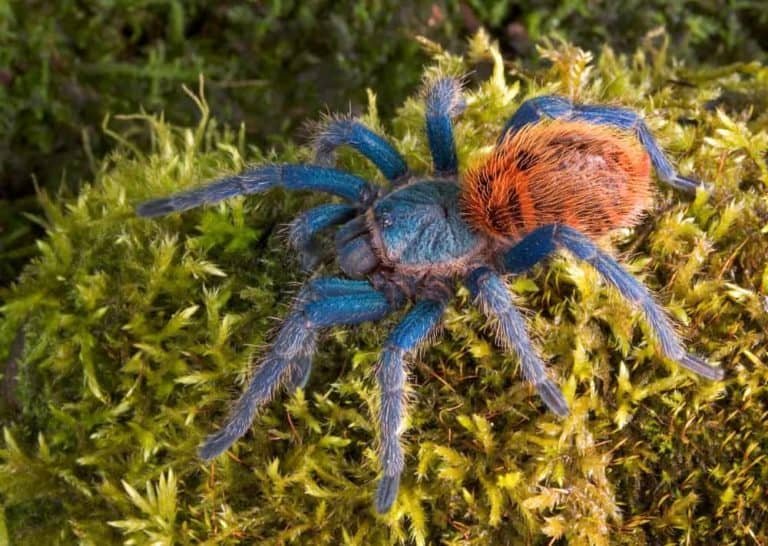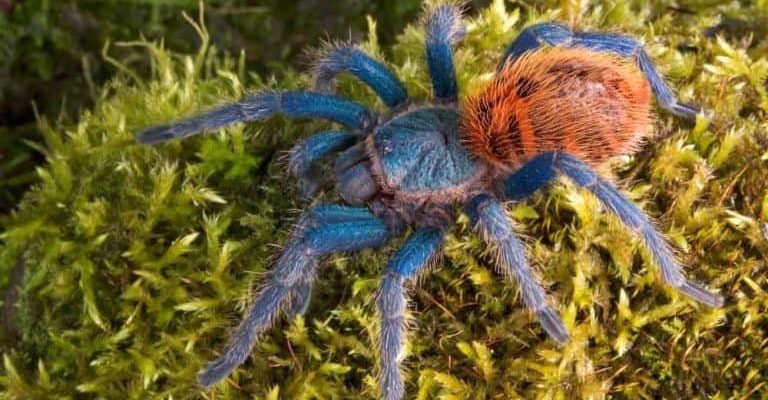
So, where does this fascinating spider call home? The *Greenbottle Blue Tarantula*, also known scientifically as *Haplopelma lividum*, primarily resides in the wilds of Southeast Asia, particularly in Myanmar and Thailand. This article will guide you through its natural habitat, behaviors, and why this spider is such a captivating creature to observe in the wild.
Understanding the Habitat of the Greenbottle Blue Tarantula
The *Greenbottle Blue Tarantula* thrives in a specific type of environment. These spiders love humid, tropical forests, where dense vegetation offers ample places to hide and hunt. You’ll often find them in areas rich with leaf litter and decaying plant matter, which provides not only food but also shelter. They dig burrows or take refuge in crevices, making them masters of concealment.
One of the reasons these tarantulas are so well-suited to their habitat is their ability to adapt. They typically create silk-lined burrows that can reach depths of several feet. This burrow serves multiple purposes: it acts as a home, a hunting ground, and a safe spot to retreat from predators. Honestly, if you were a tarantula, wouldn’t you want a cozy underground pad like that?
Geographical Distribution of the Greenbottle Blue Tarantula
The primary regions where the *Greenbottle Blue Tarantula* is found include Myanmar and Thailand, but they also inhabit parts of Cambodia and Laos. Picture the jungles of Southeast Asia, with their thick, towering trees and vibrant flora. Here, these tarantulas flourish amidst the humidity and warmth, which are essential for their survival.
In Myanmar, particularly, the ecological conditions are just right. The jungles are filled with both prey and hiding spots. As you explore this terrain, you might notice how the humid air feels heavy and alive—just like the bustling ecosystem that supports the *Greenbottle Blue Tarantula*.
Climate and Local Conditions
The climate where the *Greenbottle Blue Tarantula* lives is typically tropical. This means warm temperatures and high humidity all year round. The ideal temperature for them ranges from 75°F to 85°F (about 24°C to 29°C), with humidity levels often exceeding 70%.
Imagine standing in a rainforest, feeling the moist air on your skin. This environment is perfect for these tarantulas as it aids in their molting process, which is crucial for growth. If you were to keep one as a pet (though that requires a lot of preparations), it would be essential to replicate these conditions to keep the spider happy and healthy.
Diet and Hunting Behavior
The *Greenbottle Blue Tarantula* is a carnivorous creature, and its diet typically consists of insects like crickets, roaches, and other small arthropods. Here’s the thing: they are ambush predators. This means they don’t chase down their food but rather wait patiently in their burrows until something delicious wanders by.
When the opportunity arises, these tarantulas strike quickly. With their powerful front legs, they can catch prey with incredible speed, injecting venom to paralyze it before consuming it. It’s a bit like a stealthy game of hide and seek, where the tarantula comes out on top. Imagine how thrilling it must be for them to secure a meal!
Threats and Conservation Status
Even though the *Greenbottle Blue Tarantula* is a resilient species, it’s important to recognize the threats they face. Habitat loss due to deforestation and urbanization is a significant issue, as it reduces the available space for these spiders to thrive. Additionally, they are sometimes collected for the pet trade, which can further impact wild populations.
Conservation efforts are crucial to ensure that this beautiful tarantula continues to thrive in its natural habitat. Organizations are working to educate the public about the importance of these creatures and the need for sustainable practices in their native regions. Protecting their environment is essential for maintaining the balance of the ecosystem as well.
Interactions with Humans
While these tarantulas may not be the friendliest of pets (they’re known for being a bit defensive), they play a critical role in their ecosystem. As natural pest controllers, they help keep the populations of insects in check. However, it’s important to remember that they can be quite intimidating if encountered in the wild.
If you’re lucky enough to spot a *Greenbottle Blue Tarantula* in nature, keep your distance and admire from afar. They’re not out to get you, but they will defend themselves if threatened. In many cultures, tarantulas symbolize the mysteries of the wild, serving as reminders of nature’s wonders.
So, where is the *Greenbottle Blue Tarantula* found in the wild? Primarily in the lush jungles of Southeast Asia, these fascinating spiders thrive in humid, dense environments. They exemplify the complexity and beauty of nature, from their vibrant appearance to their critical roles in ecosystems.
By understanding their habitat, diet, and the threats they face, we can appreciate these remarkable creatures even more. Next time you think about tarantulas, remember the *Greenbottle Blue Tarantula* and how it captures the heart of wildlife enthusiasts and researchers alike. Embracing these wonders helps us foster a deeper connection with the natural world.

